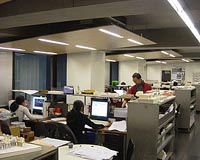 |
Cambridge MA (SPX) Nov 04, 2009 With over 31,000 miles of underground cable running along the streets of Manhattan accessible by 51,000 manholes, maintaining the electrical system that was built over a century ago is a huge challenge for Con Edison, New York City's electrical utility. Add to that rising costs, limited budgets, and a new mandated inspection program and it is clear that a system for prioritizing manholes in need of repairs and upgrades is critical. MIT Sloan School of Management Professor Cynthia Rudin and her colleagues recently took on this challenge by creating a statistical model of manhole vulnerability to help Con Edison prioritize maintenance and repairs. Manhole events such as fires, explosions, and smoking manholes are a significant problem for many cities. In Manhattan, there are a few hundred of these events every year, often as a result of problems in the low voltage secondary distribution network that provides power to residential and commercial customers. The cables, which are of varying age, quality, and dependability, are periodically inspected, and Con Edison aims to find the best way to prioritize those inspections and repairs. "Each repair takes time. They have a limited amount of repair crews and supplies, so they need to prioritize manholes that are potentially vulnerable," she explains. "The idea is that if they can preemptively repair many of the vulnerable manholes sooner then it lessens the chance of future events." By applying a new type of statistical machine learning technique to the available data, Rudin and her research team created a ranking of manholes. She adds that to validate their findings, some of the data was withheld and the team was asked to "predict" which manholes would have had fires and explosions back in 2007. "It's a difficult prediction problem because you never know whether the state of each manhole in reality matches the information we pulled from the data, but we did very well. Our findings were highly significant," she says. The prioritization algorithm used by the team is very general and can be applied for many different purposes and in many industries such as generating movie or book recommendations, says Rudin, noting that her team is now applying it to manholes in the Bronx, Brooklyn, and Queens. The data used for Rudin's model includes over 61,000 Con Edison "trouble tickets" written about electrical problems in Manhattan over the last decade. The tickets were recorded mainly by Con Ed dispatchers, and required many levels of processing in order to accurately represent the past events. Rudin's team used sophisticated information extraction and natural language processing techniques to interpret the tickets, and the team used these same techniques to process Con Edison's historical cable data. As part of the project, the team designed a software tool that produces an automatically generated report for any given manhole in Manhattan. This "report card tool" provides Con Edison with specific information about what cables are inside any given manhole, events that occurred at that particular manhole as well as nearby events, and the manhole's inspection history. "This tool puts together everything they need to know to approximately judge the vulnerability of a manhole," says Rudin. Results from the manhole project are described in "Predicting Manhole Events in Manhattan: A Case Study in Extended Knowledge Discovery" by Rudin at MIT Sloan, team members Rebecca Passonneau, Axinia Radeva, and Haimonti Dutta from Columbia University, and Steve Ierome and Delfina Isaac from Con Edison. The results from the report card project are presented in "Report Cards for Manholes" by Radeva, Rudin, Passonneau, and Isaac. Share This Article With Planet Earth
Related Links MIT Sloan School of Management
 Majority Of Working Adults Willing To Sacrifice Comfort To Save Energy
Majority Of Working Adults Willing To Sacrifice Comfort To Save EnergyMilwaukee WI (SPX) Nov 04, 2009 Business owners should think twice before tweaking workplace temperature settings this fall. According to a new survey of office workers, sixty-nine percent said they would be willing to sacrifice their preferred ideal temperature in the office to help their company conserve energy. However the survey also found that nearly four in five participants (78 percent) say they are less ... read more |
|
| The content herein, unless otherwise known to be public domain, are Copyright 1995-2009 - SpaceDaily. AFP and UPI Wire Stories are copyright Agence France-Presse and United Press International. ESA Portal Reports are copyright European Space Agency. All NASA sourced material is public domain. Additional copyrights may apply in whole or part to other bona fide parties. Advertising does not imply endorsement,agreement or approval of any opinions, statements or information provided by SpaceDaily on any Web page published or hosted by SpaceDaily. Privacy Statement |